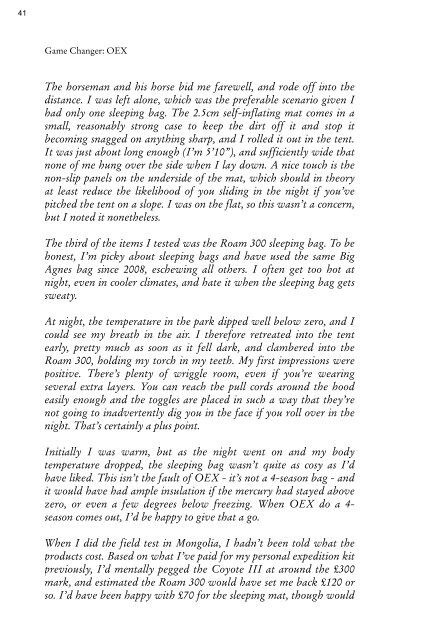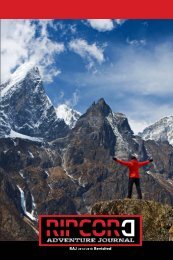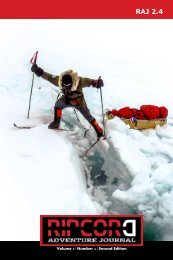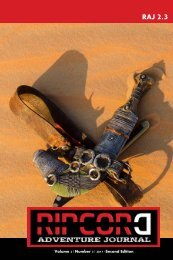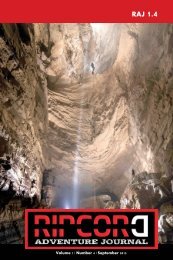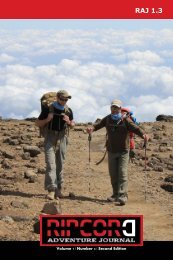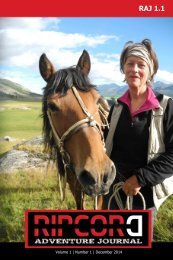Ripcord Adventure Gear Guide #1
Ripcord Adventure Gear Guide is a new quarterly publication with high-quality, authoritative editorial with first hand reviews of adventure gear and provides a comprehensive listing of the best gear in each sector with ratings provided by world explorers who will test the gear in real world situations. We hope that Ripcord Adventure Gear Guide will become the adventure enthusiasts’ almanac.
Ripcord Adventure Gear Guide is a new quarterly publication with high-quality, authoritative editorial with first hand reviews of adventure gear and provides a comprehensive listing of the best gear in each sector with ratings provided by world explorers who will test the gear in real world situations. We hope that Ripcord Adventure Gear Guide will become the adventure enthusiasts’ almanac.
You also want an ePaper? Increase the reach of your titles
YUMPU automatically turns print PDFs into web optimized ePapers that Google loves.
41<br />
Game Changer: OEX<br />
The horseman and his horse bid me farewell, and rode off into the<br />
distance. I was left alone, which was the preferable scenario given I<br />
had only one sleeping bag. The 2.5cm self-inflating mat comes in a<br />
small, reasonably strong case to keep the dirt off it and stop it<br />
becoming snagged on anything sharp, and I rolled it out in the tent.<br />
It was just about long enough (I’m 5’10”), and sufficiently wide that<br />
none of me hung over the side when I lay down. A nice touch is the<br />
non-slip panels on the underside of the mat, which should in theory<br />
at least reduce the likelihood of you sliding in the night if you’ve<br />
pitched the tent on a slope. I was on the flat, so this wasn’t a concern,<br />
but I noted it nonetheless.<br />
AAAAAAAAAAAAAAAAAAAAAAAAAAAAAAAAAAAAA<br />
AAAAAAAAAAAAAAAAAAAAA<br />
The third of the items I tested was the Roam 300 sleeping bag. To be<br />
honest, I’m picky about sleeping bags and have used the same Big<br />
Agnes bag since 2008, eschewing all others. I often get too hot at<br />
night, even in cooler climates, and hate it when the sleeping bag gets<br />
sweaty.<br />
At night, the temperature in the park dipped well below zero, and I<br />
could see my breath in the air. I therefore retreated into the tent<br />
early, pretty much as soon as it fell dark, and clambered into the<br />
Roam 300, holding my torch in my teeth. My first impressions were<br />
positive. There’s plenty of wriggle room, even if you’re wearing<br />
several extra layers. You can reach the pull cords around the hood<br />
easily enough and the toggles are placed in such a way that they’re<br />
not going to inadvertently dig you in the face if you roll over in the<br />
night. That’s certainly a plus point.<br />
Initially I was warm, but as the night went on and my body<br />
temperature dropped, the sleeping bag wasn’t quite as cosy as I’d<br />
have liked. This isn’t the fault of OEX - it’s not a 4-season bag - and<br />
it would have had ample insulation if the mercury had stayed above<br />
zero, or even a few degrees below freezing. When OEX do a 4-<br />
season comes out, I’d be happy to give that a go.<br />
When I did the field test in Mongolia, I hadn’t been told what the<br />
products cost. Based on what I’ve paid for my personal expedition kit<br />
previously, I’d mentally pegged the Coyote III at around the £300<br />
mark, and estimated the Roam 300 would have set me back £120 or<br />
so. I’d have been happy with £70 for the sleeping mat, though would


